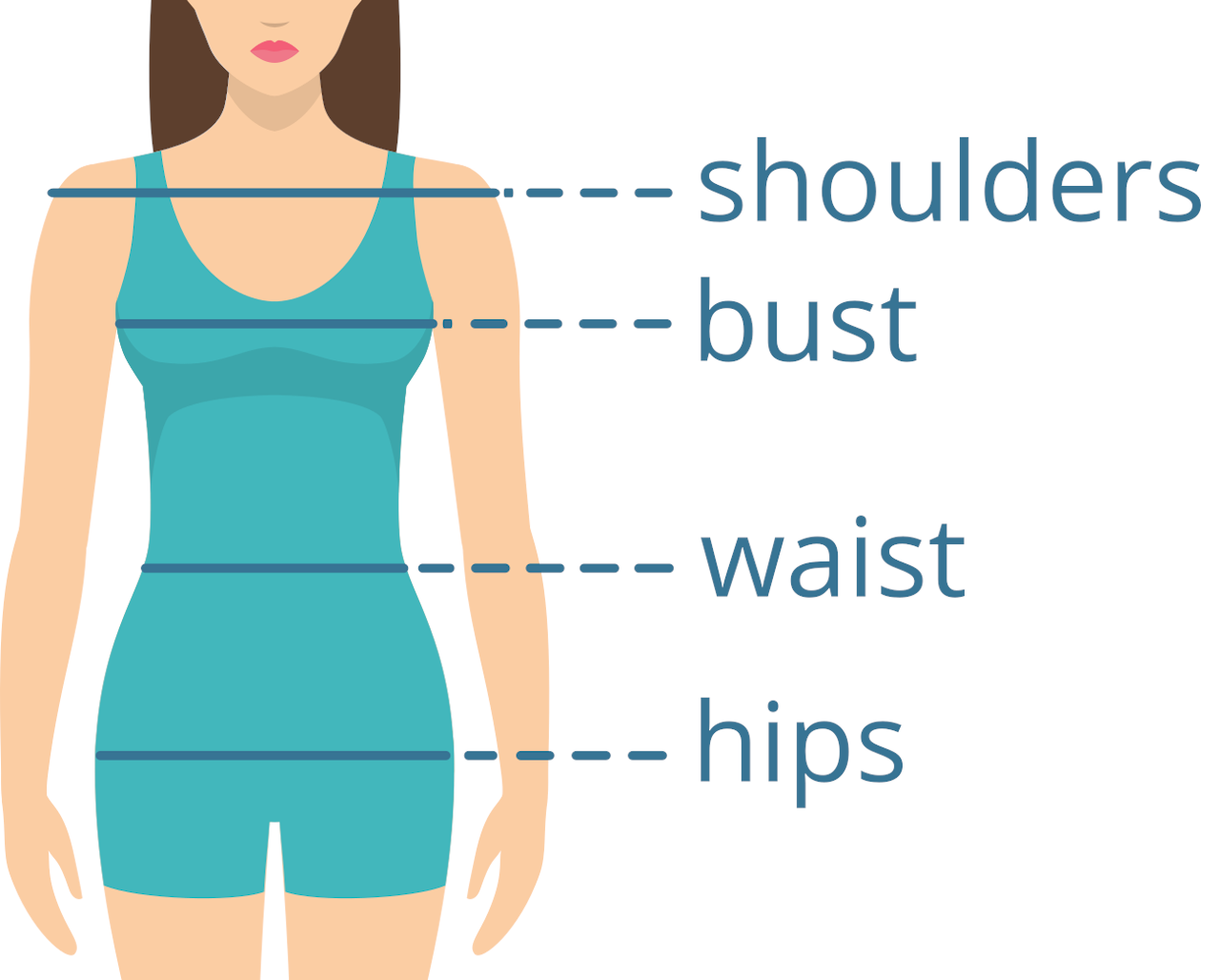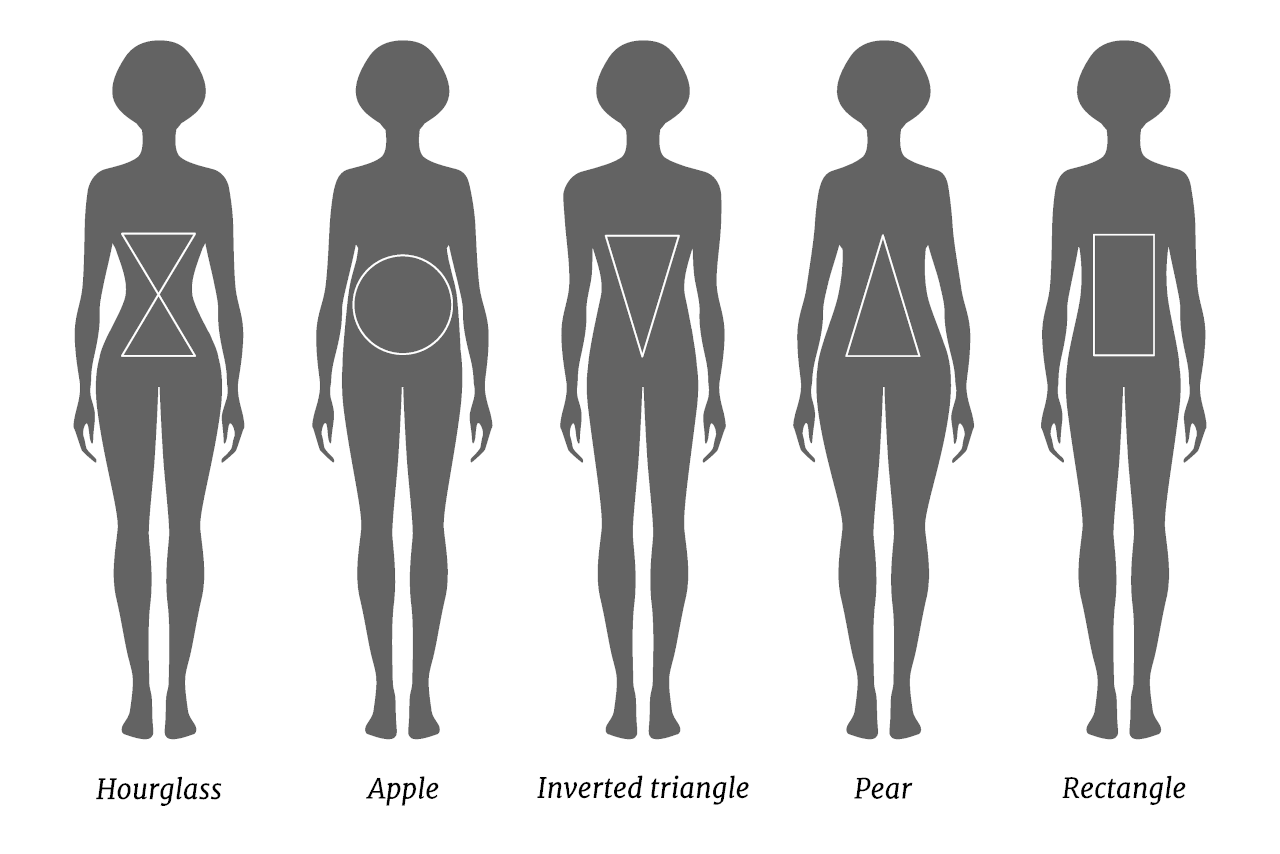Body Shape Calculator – What Body Type Are You?
Calculate your body shape given your bust, weight, and hip circumference measurements with the calculator below.

Your Body Shape:
Waist-hip Ratio
On this page:
How to Find Your Body Shape
Everyone has their own genetic makeup that influences their body shape and how their body distributes fat mass.
Conversations regarding different body shapes can often lead to negative connotations associated with superficial appearance or attractiveness. However, knowing what your body type is plays a significant role in understanding the best dietary choices and exercise routines that you can implement in order to lead a healthy lifestyle.
Understanding your body shape is also an important component in finding clothing and a style that you feel the most comfortable and confident in.
Determining your body shape takes into account certain physical measurements, such as waist-to-hip ratio. BMI might also be accounted for when discussing body shape since these two factors together can help your care team determine whether you are at risk for specific medical issues.
If you’re trying to calculate body surface area to understand metabolic mass, then you should try our body surface area calculator instead.
How to Measure Your Body Type
There are four main body measurements that are used to determine your body shape.
Use a soft measuring tape to take each of these measurements. You can always print a paper measuring tape too.

- Shoulders:
- Start at the tip of one shoulder and measure in a circle all the way around to your other shoulder. Keep the measuring tape high up around your shoulders so it almost slips off. You may need to have someone help you take this measurement.
- Bust:
- Take the measurement at the fullest point of your bust. Make sure that the tape is not too tight. You should be able to inhale and exhale freely as the measuring tape is wrapped around.
- Waist:
- Measure your waist at the narrowest portion just above your navel.
- Hips:
- For your hip measurement, stand up straight and wrap the tape measure around the widest part of the hips as viewed from the side.
For all four measurements, ensure that the tape measure is parallel to the floor for the most accurate reading. The ratio of these body measurements to one another can then give you an idea of what body type category you fall into, as described below.
What Is Your Body Shape?
There are five main body shapes that the majority of people can be classified as having. Keep in mind that everyone won’t look exactly like a particular “shape”; these images just help you determine how your body is designed.

- Inverted Triangle:
- Think of people who have an inverted triangle body shape as having broad shoulders or a fuller chest, while the hip region is smaller. For many females, a larger chest might place them into an inverted triangle shape.
- Maintaining a consistent exercise routine (that includes strength exercises for the upper body) and consuming a nutrient-dense diet can help inverted triangles maintain a healthy waistline.
- Rectangle:
- The rectangle body shape is also sometimes referred to as the “ruler,” or straight body shape. Individuals with a narrower frame tend to carry weight proportionately, but can also carry weight around their abdomen.
- According to the Cleveland Clinic, a rectangular body shape might predispose someone to osteoporosis due to a smaller skeletal frame; in this case, weight-bearing activities would be beneficial.[1]
- Round/Apple:
- Individuals with an apple-shaped body type have a waist measurement that is greater than their hip and bust measurements. This means that they have higher levels of abdominal obesity.
- According to the CDC, females with a waist measurement of 35 inches or more and males with a waist measurement of 40 inches or more might be more prone to obesity and the corresponding health risks that entail that disease.[2]
- As mentioned above, this visceral fat poses the greatest health risk. Many people with an apple-shaped body type have a greater risk of developing diabetes and cardiovascular disease, so incorporating physical activity and a whole, nutrient-dense diet into one’s routine can prove beneficial.
- Triangle/Pear:
- People with pear-shaped bodies carry more weight in their hips and thighs as compared to their stomachs and shoulders.
- Some studies have found that fat located in the hip and thigh regions is actually associated with a lower risk for cardiovascular disease compared to belly fat.[3] However, it should be noted that if you are overweight, fat loss in any part of your body is beneficial for overall health.
- Hourglass:
- This body shape resembles the image of an hourglass. Unlike an apple or pear shape, weight is not concentrated in one area of the body.
- Even though a waistline can be easily defined on those individuals with an hourglass shape, it doesn’t necessarily decrease the risk of disease. According to the Cleveland Clinic, excessive adipose tissue and corresponding health risks can still occur if body mass index is at or above 25.[1]
What Your Body Type Might Reveal About Your Health
Similar to how your waist-to-hip ratio can help predict the risk of chronic health problems and obesity, so too can body type.
Understanding what your body type tells you about how your body distributes fat can help you develop an individualized plan to maximize your health and fitness.
Abdominal fat is also known as visceral fat, which can cause a number of health problems. In fact, high amounts of visceral fat are correlated with worsening cardiovascular risk factors.[4]
Therefore, someone who is more likely to deposit fat in their midsection needs to pay close attention to their nutrition and exercise to decrease their risk factors.
Keep in mind that no body shape is “better” than another – all shapes are normal human designs, and each one can be just as healthy and active as the next.
The biggest factor to keep in mind is maintaining a healthy weight (regardless of body shape) and decreasing your risk of issues like obesity, cardiovascular disease, and diabetes, to name a few. Speak with your care team today if you’d like more information on reaching a healthy weight or developing an exercise program to help you stay functional and strong.
Similar Health Calculators
References
- Cleveland Clinic, What Does Your Body Shape Say About Your Health?, https://health.clevelandclinic.org/what-body-shape-means-for-your-health
- Centers for Disease Control and Prevention, Assessing Your Weight, https://www.cdc.gov/healthyweight/assessing/index.html
- Manolopoulos, K. N., Karpe, F., & Frayn, K. N., Gluteofemoral body fat as a determinant of metabolic health, International Journal of Obesity, 2010, 34(6), 949-959. https://www.nature.com/articles/ijo2009286
- Lee, J. J., Pedley, A., Hoffmann, U., Massaro, J. M., & Fox, C. S., Association of Changes in Abdominal Fat Quantity and Quality With Incident Cardiovascular Disease Risk Factors, Journal of the American College of Cardiology, 2016, 68(14), 1509–1521. https://doi.org/10.1016/j.jacc.2016.06.067


